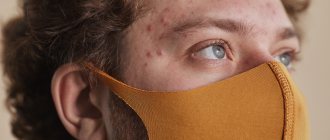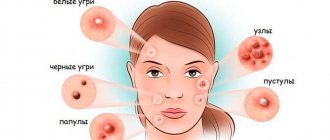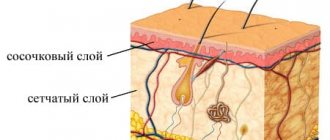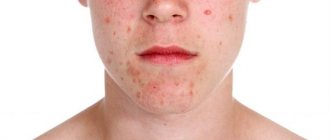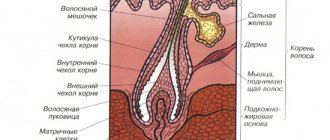The main causes of acne on the chin
In order to choose the right methods for correcting acne on the chin, we will determine the main causes of their occurrence:
- Rashes in the T-zone of the face (forehead, nose and chin) often appear due to increased sebum production. The sebaceous glands in these areas are most active, and the pores are enlarged. Excess sebum mixes with external impurities and accumulates in the pores, forming a sebaceous plug in which acne propionobacteria multiply.
- Hormonal imbalance in the body is another common cause of acne, including on the chin. Typically, acne associated with hormonal imbalance occurs during puberty in adolescents. Acne on the chin in women often breaks out during menstruation or pregnancy.
- Certain diseases can also affect the condition of the skin in this area, for example, dysfunction of the digestive system, spleen or kidney problems.
- Excessive sebum production in seborrheic areas is usually genetic and is caused by increased sensitivity of androgen receptors.
- Unsuitable skin type or insufficient care can often cause clogged pores and the appearance of acne on the face.
- Frequent stress, poor diet, and bad habits are also possible factors in the formation of rashes on the chin.
- Men have more sebaceous glands on their skin than women, and high levels of testosterone stimulate increased sebum synthesis. Also, in men, red pimples on the chin may break out after shaving.
Classification of acne on the chin in dermatology
In dermatology, there are several types of rashes:
- Papules
are small subcutaneous tubercles without purulent contents. - Pustules
are classic pimples with purulent contents. - Comedones
(open and closed) - sebum accumulates in the ducts of the sebaceous glands and forms a subcutaneous white “head” or superficial blackheads. - Nodules
are hard, large and deep pimples, often accompanied by purulent discharge and painful sensations, indicating a strong inflammatory process and a high risk of scarring.
Depending on the age at which the rash appeared, acne is also divided into:
- children (allergic, inflammatory rashes);
- teenage (a lot of acne on the face due to hormonal changes in the body);
- acne in adulthood (acne on the face appears after 18 years);
- acne caused by external causes (for example, taking steroid or hormonal drugs).
How to properly care for skin prone to acne on the chin?
Increased sensitivity of the sebaceous glands or hormonal fluctuations are most often genetic in nature. Therefore, it will not be possible to radically change oily problem skin type to normal with the help of aesthetic procedures or home care, but it is possible to significantly improve its condition.
You can reduce shine, correct visible imperfections on the chin and prevent their reoccurrence with the help of a highly effective beauty routine for oily problem skin. Such products may include sebum-absorbing mattifying components, ingredients with soothing and skin-restoring effectiveness.
Rules for caring for oily problem skin:
- In the morning and evening, gently but thoroughly cleanse the skin of excess sebum and external impurities. As part of the cleanser formula, look for antibacterial (tea tree oil, AHA acids, piroctone, olamine) and moisturizing components, as well as keratolytics (hydroxy acids), which carefully remove dead cells of the stratum corneum. Use gentle cleansers, such as gels and foams, designed specifically for oily, problem skin.
- The next step is to use a lotion or tonic for oily skin prone to rashes and imperfections. Such products additionally remove residual impurities and cleansers from the skin, help tighten pores and prepare the skin for subsequent care.
- For deep cleansing and renewal of the skin, delicate exfoliants based on soft acids are suitable, which dissolve the stratum corneum of the epidermis without injuring it. Twice a week, apply mineral masks to problem areas to promote deep cleansing and reduce pores.
- For daytime care, a mattifying product with moisturizing properties is suitable; at night, apply soothing and intensively restoring formulas to the skin.
- Do not try to get rid of internal acne on the chin on your own - this will make the situation worse and can lead to scarring and new inflammation.
Treatment of internal subcutaneous acne on the forehead and chin in women and men
Some types of defects cause serious discomfort; they hurt, sometimes itch, are constantly inflamed, not to mention spoiled appearance, because a rash can appear at the most inopportune moment. Let's figure out what methods of struggle modern cosmetology has prepared for everyone.
Beauty care
If you have skin prone to rashes, it is unlikely that you will be able to cope with the problem with just the right and timely care measures. However, in some cases they are extremely effective. It is necessary to look after the dermis so as not to aggravate the situation. Therefore, it makes sense to consider the most common and truly working recommendations:
- Don't chase deep cleaning and overdo it with acidic products. In some cases, this may provoke the appearance of new formations.
- Before applying the care, all decorative makeup should be removed with hydrophilic oil or micellar water.
- The packaging of the products must clearly indicate “Non-comedogenic”.
- Approximately 1-3 times a week you can make masks for deeper cleansing.
- Be sure to remember about moisturizing, especially if your skin type is oily, because it requires even more moisture than in the case of dry skin.
It must be remembered that all accessories, for example, sponges, spatulas for creamy textures, etc., must be thoroughly and thoroughly washed after each use. During application, skin particles remain on them, which begin to decompose, and during storage, hundreds of thousands of bacteria from the environment settle.
Face cleaning
The procedure is very effective, as it allows you to remove all impurities from the surface, as well as deeply clean the channels and ducts of the glands. Cosmetology offers many options on how to normalize metabolic processes and restore health, smoothness, elasticity and beauty to the dermis. Main types of cleanings:
- mechanical;
- laser;
- ultrasonic;
- mesotherapy;
- phototherapy and others.
Prescribing treatments on your own is a bad idea. If chosen incorrectly, they can seriously aggravate the situation. A person will get post-acne, which will be much more difficult to get rid of than the rashes themselves. Only a doctor or qualified cosmetologist will help you choose what will actually be effective.
Peelings
With the help of such procedures, dead cells are removed from the surface of the dermis. This helps not only to cure acne, but also to even out the texture of the skin, making the skin shine clean and healthy. There are several types of interventions that are prescribed, depending on the symptoms and characteristics:
- retinoic or yellow;
- mechanical;
- Jessner;
- hardware;
- chemical and others.
Oxygen-ozone therapy
This method has the widest range of indications, because ozone in therapeutic dosages can have the following effects:
- anti-inflammatory;
- antibacterial;
- antiviral;
- immunomodulatory;
- anesthetic;
- antifungal and others.
The main objective of the effect is to improve the supply of oxygen to epithelial cells by stimulating blood circulation and microcirculation in the capillaries. Thanks to the lipolytic effect of the gas, good results are also achieved in the fight for clean skin without blackheads and acne.
Laser resurfacing
Essentially, this is a deep peeling, in which the upper thin layer of the epidermis is removed using a laser. It provokes increased production of elastin, as well as collagen, due to which maximum rejuvenation is achieved, spider veins, age spots and unpleasant rashes and irritations are removed. There are several types of procedure:
- factional;
- CO2 (carbon dioxide);
- erbium.
Laennec
The modern placental drug is an extremely effective innovative remedy for getting rid of many problems. It has hepatoprotective and immunomodulatory effects. The form of release in ampoules allows it to be used by injection.
How to remove acne on the chin using salon procedures?
In addition to home corrective care for oily problem skin, you can contact a cosmetologist who will recommend aesthetic procedures appropriate for your type and condition of the epidermis, for example, cleansing to cleanse and reduce large pores or peelings that promote renewal, as well as even out the relief and tone of the epidermis.
Remember that salon care does not replace a basic home routine: daily self-cleansing, toning, moisturizing and mattifying will help maintain oily skin in between visits to the cosmetologist.
Timely treatment
Only a dermatologist can determine why pimples, blackheads and acne appear on the skin. If you do not go to him on time, you can greatly aggravate the problem. In some cases, the inflammatory process grows so much that harmless pimples turn into cysts, which can only be removed through surgery.
No one wants to go under the surgeon’s knife, so it’s best to think through all the risks in advance and contact a specialist without delaying it. The doctor will indicate which tests to take, find out why this happens, and give competent recommendations. Only in this way can you achieve an acceptable result without risking your own health.
Review of La Roche-Posay products for skin prone to imperfections
If you have painful acne on your chin, corrective care for oily problem skin will help reduce visible imperfections. LRP products are highly effective, proven by independent studies. La Roche-Posay's Effaclar product formulas for oily problem skin contain active ingredients that contribute to a noticeable improvement in the condition of the epidermis and noticeable cleansing of the skin.
What products to choose for skin care prone to imperfections:
- If you have single imperfections, including those on the chin, try a topical product, for example, Effaclar AI Corrective Treatment for Oily Problem Skin The formula contains Niacinamide soothes the skin and prevents the development of imperfections, piroctone olamine is known for its antibacterial properties, lipo-hydroxy acid gently exfoliates , promoting the process of skin cell renewal.
- Effaclar Ultra micellar water for oily problem skin will help to gently cleanse your face without water and effectively remove makeup residues; it mattifies the skin well and visibly cleanses pores. For supporters of classic washing, Effaclar gel foaming gel with physiological pH and hypoallergenic non-comedogenic formula is suitable, delicately cleansing pores and removing excess sebum.
- After cleansing, wipe your face with a cotton pad moistened with a small amount of Effaclar Pore Tightening Lotion with a mattifying effect, which will help reduce facial oiliness and help even out skin tone and texture.
- Also suitable for caring for oily problem skin are products with antioxidants, epidermis-renewing AHA and BHA acids, niacinamide, piroctone-olamine and hydrofixing agents to prevent skin dehydration. Pay attention to the Corrective Emulsion for Oily Skin Effaclar K (+) or the Moisturizing Mattifying Emulsion Effaclar Mat. The product formulas not only help reduce facial shine, but also intensively moisturize oily skin, help strengthen the protective functions of the epidermis and prevent the appearance of new imperfections on the chin.
- Corrective cream-gel for problematic skin against imperfections and post-acne Effaclar DUO (+) with LHA acid, procerad and niacinamide will help to even out the tone and texture of the face, as well as smooth out stagnant spots after acne on the chin. The product stimulates cellular renewal of the epidermis, helps reduce post-acne, and moisturizes the skin well.
EFFACLAR AI
Local action corrective agent
Effectively affects imperfections and prevents the appearance of post-acne.
RUB 1,417 more details
EFFACLAR GEL
Cleansing foaming gel against acne
Cleanses the skin and pores of impurities, removes excess sebum.
951 rub. more details
EFFACLAR
Pore tightening lotion
Smoothes the skin surface, cleanses pores, mattifies.
RUB 1,468 more details
EFFACLAR MAT
Mattifying sebum-regulating emulsion
Eliminates oily shine, mattifies the skin for 6 hours, tightens pores.
RUB 1,618 more details
EFFACLAR DUO(+)
Corrective cream-gel
Instantly moisturizes and mattifies the skin, reduces imperfections and redness caused by them. After 8 days of regular use, the number of imperfections is noticeably reduced.
RUB 1,187 more details
Mistakes in caring for oily skin that can cause acne on the chin
Here are the most common mistakes that people with problem skin types make:
- The desire to get rid of excessive oiliness and small pimples on the face by intensive cleansing or squeaky cleansing can negatively affect the condition of the problematic epidermis: the natural hydrolipidic barrier of the skin is disrupted, dryness, dehydration, peeling and irritation appear. At the same time, sebum production increases, which in turn contributes to the emergence of new rashes.
- The use of nourishing and thick creams in the beauty routine, which create a thick, oily film on the surface of the epidermis, can further clog the pores and provoke new rashes on the chin. Such products are more suitable for dry or normal skin types. Non-comedogenic formulas are suitable for caring for oily skin.
- Using formulas with a high alcohol content will also not solve the problem of oiliness or get rid of breakouts. Alcohol can dehydrate the skin; this ingredient, of course, does not have a soothing or restorative effect. Instead, include products based on AHA and BHA acids, such as salicylic or glycolic acids, into your beauty routine, which additionally have a noticeable exfoliating effect and promote skin cell renewal.
- Insufficient hydration is another possible cause of facial rashes. Dehydrated, oily skin reacts by increasing the synthesis of sebum in order to self-hydrate. Choose formulas based on mattifying and moisturizing ingredients that prevent dehydration and at the same time reduce facial oiliness.
Skin care after cleansing
The principles of home care should be carefully described by a cosmetologist. He can also recommend treatment products to improve and prolong the results. Recommendations in the first week after the procedure134:
- do not sunbathe, do not visit the solarium;
- avoid too high or too low temperatures (sauna or prolonged exposure to cold);
- do not visit the pool;
- use creams with high levels of UVA and UVB filters;
- instead of chlorinated water, wash your face with distilled or chamomile infusion;
- Do not use scrub, soap, or products containing alcohol.
After visiting the salon, you should not touch your face with your hands, and also immediately apply makeup.
How to prevent the formation of new acne in the chin area?
To prevent acne on the chin, follow the recommendations of Alexander Prokofiev, a dermatologist and medical expert of the La Roche-Posay brand:
- Don't forget about moisturizing oily problem skin: lack of moisture in cells causes dehydration, which provokes increased sebum production and excessive shine in the T-zone.
- If there are a lot of painful acne on your face, be careful when choosing decorative cosmetics - choose formulas that do not clog pores. Try an imperfection-concealing product for oily problem skin with a non-comedogenic composition and a light degree of concealment, for example, Effaclar Duo(+) Unifant Corrective Cream-Gel, which well evens out the tone and texture of the face without clogging the pores.
- Cleanse your face twice a day using gel cleanser or micellar water for oily skin if you prefer waterless cleansing. Deep cleanse your skin twice a week, use gentle scrubs, peels and clay masks.
- Choose care with antibacterial, soothing, mattifying properties and formulas based on zinc, niacinamide, acids (AHA, linoleic, salicylic, hydroacids), niacinamide, piroctone-olamine, antioxidants, probiotics.
How to treat acne with a cosmetologist: types of professional cleanings
Facial cleansing is not a daily procedure. It should be performed by an experienced cosmetologist. The following types of procedure exist:
- Mechanical or manual. It is carried out with your fingers, a special tool (uno spoon) or a vacuum device after preliminary steaming of the face. If you have red pimples* (papules) or rosacea, it is better to avoid manual cleansing in favor of acid peeling, since the likelihood of re-infection is very high, and steaming the inflamed skin can aggravate the problem of painful acne*.
- Chemical. It is carried out using various exfoliating substances, such as fruit acids (lactic, tartaric, glycolic, citric, malic, salicylic, azelaic, etc.). This is a fairly gentle treatment, suitable for sensitive skin with acne. While cleansing the epidermis, it also has an anti-inflammatory effect;
- Iontophoresis. With the help of galvanic current, beneficial substances are transported into the upper and middle layers of the dermis for therapeutic purposes, which narrow dilated capillaries, helping to remove comedones and improve tone.
- Cavitation peeling. Carried out using ultrasound. Deeply cleanses pores, which promotes the penetration of nutrients into the epidermis and improves oxygenation. Cavitation exfoliates dead skin particles and has a rejuvenating effect.
The cosmetologist should select the procedure. It is not performed in the presence of inflammatory elements.

